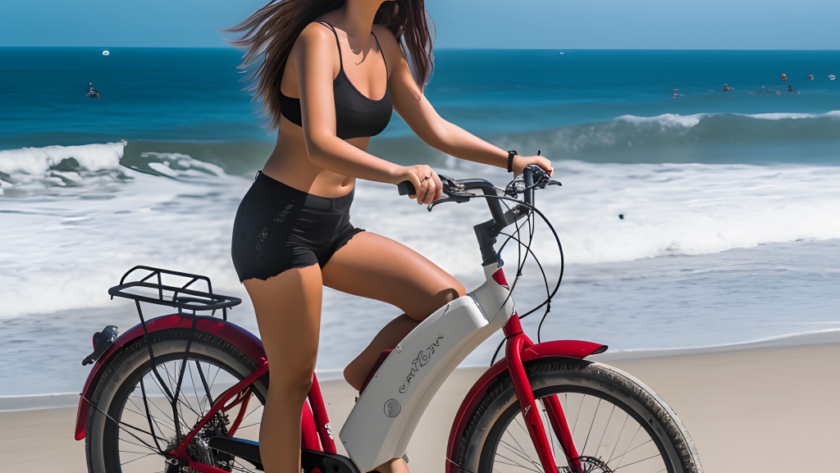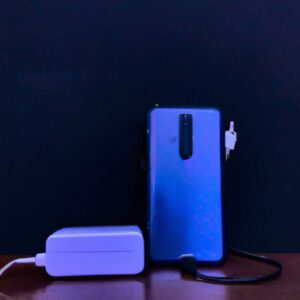Understand your e-bike’s battery life and range
One of the most important things to consider when it comes to an electric bike is its battery life and range. This will determine how far you can go on a single charge and ultimately impact your riding experience.
It’s important to keep in mind that different factors can affect your e-bike’s battery life, including terrain and weather conditions. For instance, hilly or mountainous terrain may drain your battery faster than flat terrain, as more power is required to make it up the inclines. Similarly, extreme weather conditions like hot or cold temperatures could reduce the battery’s efficiency.
To ensure the best performance from your battery, understanding each factor would be important to help you gain more insight into your e-bike’s limit. Your manufacturer will always state your battery size, so you can calculate the ideal running time based on this information.
Checking range usefully will enable periodic replacements at the perfect intervals for another cycling session. Check out additional tips that can expand your e-bike operating range
Choose the Right Battery for Your E-Bike
One of the most crucial needs in any electric bike is the battery. Not all batteries are the same, and choosing the right one will significantly impact your e-bike’s performance and endurance. Consider a larger capacity battery if you routinely ride long distances. In general, lithium-ion batteries are the most efficient and dependable option.
The Lithium-ion batteries have emerged as the best smartphone batteries recently. This is because they’re low-maintenance, lightweight and can retain power even when not in use– making them even more practical for e-bikes! These batteries can carry a higher voltage than various other rechargeable energy storage options, resulting in increased energy density and lower discharge rates. What makes Lithium-ion stand out is its ability to charge faster and offer excellent shelf life compared to the average battery– that way, the charge lasts would commonly come about than other popular choices.
- Battery Life:
- The distance you can travel on each charge is referred to as range, and your battery’s size will determine it.
- Your typical daily cycling demand and the range of your e-bike should match the battery capacity.
- E-bikes travel faster at higher rates, so always consider purchasing an e-bike battery which can cope with your choice in biking style so avoid biking at unnecessary high speeds.
The advantages and disadvantages are in reach, battery service lives dependent on various variables like speed settings or topography. Opt just with dealerships that provide genuine aftermarket components including warranties authorized by leading brands beyond bogus low-priced knockoff prototypes elsewhere.
Overall, storing your battery correctly and maintaining good care to increase the lifespan and safety whilst riding at longer ranges is critical. To improvise sooner or later in choosing the battery’s power level, upgrade compatibility requirements to match the hardware; favorable suitability level complies with legal regulations and road forces to improve cycling safety environments.
Optimize Your Pedal Assist Settings to Save Power
If you want your e-bike to run longer on a single charge, be sure to optimize your pedal assist settings. Typically, most electric bikes have a control feature on the handlebars that allows the rider to adjust the amount of assistance they receive from the motor. It is essential to operate the pedal assist with the lowest settings if it still works for your riding purposes.
Remember, every bit of help from the motor will require some battery power, so if you are aiming to go further, opt for pedaling harder instead. According to the terrain and how much energy you have left in the battery, you may need to tweak your pedal assistance setting accordingly as you go.
- Adjust Settings Based on Terrain: If you are riding in the mountains or hilly terrain, it is essential to consider the uphill climbs. In such a scenario, leverage higher assist settings when ascending hills. However, ensure you turn it back down when descending to conserve power.
- Adjust Settings Based on Your Needs: Consider adjusting your level of assistance based on what you want to achieve during your ride. If you need more exercise, use less assist, whereas if you plan for an easier ride or carry cargo with you, choose higher settings but minimum enough to meet the requirement
Make sure you take this measure further by finding the right gear and cadence timing. Riders who can shift gears often find an easier time getting the assist they perform during hill climing.
In sum, optimizing your pedal assist settings makes all the difference in extending your e-bike’s battery life. The idea here is to use assistance minimizing the battery power consumed by the machine and avoid unnecessarily straining the motor. Reducing reliance on assist improves cycling experience on electric bikes, converting them to regular bikes mid-ride in turn giving the battery a break.
Adjust Your Riding Style
One way to save battery on your e-bike is to adjust your riding style. Riding at a steady pace instead of constantly accelerating and braking allows your battery to maintain a consistent power demand. When you accelerate and brake frequently, the stress placed on your battery becomes more significant, causing more power to drain faster.
If possible, avoid overly steep hills. Their inclines consume a lot of power, and it’s sure to drain your battery more quickly than a flat ride will.
Try reducing the number of unnecessary items you carry on your bike too. Carrying extras ultimately adds weight that’s harder for the battery to carry. By decluttering your junk, you can enjoy lighter, more efficient rides.
- Ride smoothly and keep steady speed
- Avoid steep inclines when possible
- Don’t bring too much extra weight with you
Adjusting your riding strategy really is about reducing resistance wherever you can. By avoiding rough stops, bumpy roads, dense hills or even carrying too many accessories, you’ll reduce resistance on the bike, making it move with much more ease.
Keep your tires inflated
Believe it or not, keeping your e-bike’s tires properly inflated can make a huge difference in conserving battery power. When your tires are underinflated, they create increased resistance on the road surface thus making it harder to ride compared to when they are fully pumped up to their recommended PSI level. This means that your e-bike will have to work harder to maintain speed, which uses more battery power. On the other hand, properly inflated tires create less friction, making your e-bike roll more efficiently and ultimately help conserve battery power.
Not only does keeping your tires inflated properly improve overall efficiency and minimize energy loss, but it makes your ride smoother and reduces your risk of getting a flat tire during your ride. It is recommended that you check your e-bike’s tire pressure regularly, every few days. Especially before you go for a long journey. Read the manufacturer’s instructions to know to how much your bike’s tires should be inflated.
An easy tip is to use a regular tire gauge tool available from any local bike store and nozzle adapters readily available too. Mostly, e-bikes use Presta type valves, which need a narrower nozzle while others use bigger Schrader valves like what Cars and motorbikes use. An electric pump leveraged to primarily worth investment by riders- particularly during the winter – don’t have to worry about dismantling punctured wheels completely out in the open elements.
- Regularly monitor your e-bike’s tire pressure, especially if you’re going for long rides
- Ensure your tires are inflated to the recommended levels specified by your e-bike’s manufacturer
- Use an appropriate tire pressure gauge for accurate readings.
In conclusion, maintaining correct tire pressures does not require complex bike maintenance skills; if the process is followed consistently, the benefits go beyond effective battery usage.
Monitor your speed to conserve your e-bike battery life
If you’re looking to extend your e-bike’s battery life, keeping track of your speed is essential. Your battery’s power tends to decrease as your velocity increases. Higher speeds can consume more energy, much like cars require more gas the faster they go.
Slowing down will have a variety of benefits for both your battery life and overall ride quality. Not only does it help reduce your power consumption, but sticking to slower speeds will give you more control and increase your safety while riding.
Going at a steady pace not only reduces your overall energy consumption, but it also ensures that you get more out of your battery. If you feel the temptation to speed up, remember; While going faster might seem more thrilling, it will ultimately mean using more power from your battery, so pick an ideal and moderate speed for the road you will tackle.
- TIP: Use cruise control if your bike has it. This feature allows you to set the maximum speed you want your e-bike to maintain. This way, you don’t have to wonder about adjusting your speed and instead can focus your attention on the path ahead.
In summary, speed is something you need to keep in mind when it comes to battery life, find the perfect moderate range suitable for your outing. Doing this will certainly make sure you don’t unnecessarily consume batteries and you will have more charge left for future rides.
Reduce resistance with maintenance
If you want to save battery power on your e-bike, you need to reduce the resistance caused by mechanical friction. Dirt and grime can accumulate on the various parts of your e-bike, such as the chain, pedals, spokes and cassette, causing added resistance and wasting battery power.
To prevent this from happening, it’s crucial to keep your e-bike clean and well-maintained. This will not only extend the life of your components, but also ensure a more efficient and enjoyable ride.
- Clean your e-bike: Use a soft cloth and non-corrosive cleaner to remove accumulated dirt and dust from all the surfaces of your bike. Pay special attention to the chain and rear derailleur.
- Lubricate the chain: The chain is one of the most important mechanisms in an e-bike. A dry and rusty chain will put a lot of pressure on your battery, so it’s essential to lubricate it using high-quality bike lubricant. Try to use cleaner before oiling.
- Pay attention to your wheels: Your e-bike’s wheels must be aligned and balanced before riding. Check to make sure they are straight and properly inflated. Spokes should be tightened when necessary to minimize friction.
Regular maintenance not only protects your investments and extends their lives, it also gives you a high quality e-bike riding experience that you will come to know and love
By taking care of basic bike upkeep and cleaning, you will avoid unwanted mechanical resistances that lower your power consumption. Keep the time- and volume-appropriate servicing listed above in mind, your bike will emerge happier, faster, and smoother for all of your excursions!
Keep Your Battery Well Charged
Your e-bike’s battery is the its lifeblood, and proper care of it is crucial to ensuring you get the most out of your electric bike. Following the manufacturer’s instructions for charging your battery correctly is essential in maintaining longer-lasting and reliable power for your e-bike.
It is important to never let your battery completely drain before recharging. Charging your battery correctly helps protect battery health prolonging its lifespan. Most manufacturers recommend charging the battery when it drops to around 50% to avoid damaging the cells and ensuring a full charge without power fluctuations.
Charging your battery fully is also critical. Overnight chargers that stop charging the battery once it reaches 100% battery can improve the longevity and that difference gets even greater over time with how frequent you charge your battery—which means getting ninety percent everyday twice would deplete the battery faster compared to one hundred percent once a day because it becomes less impacted especially if instructions are mistakenly disregarded. Checking the charger’s guidelines for accurate usage can extend battery durability which equals extended happiness with your e-bike.
An important note is keeping your battery clean as dirt creates sources of heat and or cause dissatisfaction during charging which usually deplete the handy charge quickly.
- Remember always check:
- Battery capacity during purchase best one for your planned activities;
- Minimum and optimal after riding protection practices before storing, – refer to recommendations that come with the product;
- Importantly – how to correctly store your batteries safely after use
Properly following these guidelines and regulations will keep your e-bike’s battery running smoothly, and helping that longevity makes an efficient over lifetime delivery of cost effectively working vibes remember to read into the ultimate manual, for a safer and protective e-biking endeavor of future vitality.
Charge your e-bike at the right time:
Charge your bike when it’s around halfway discharged instead of frequently topping it off between rides. I know it may be tempting, but overcharging can cause damage to your battery’s lifespan and functioning.
Fully charging a lithium-ion battery cell increases its temperature and generates stress on internal components, which can cause the battery to swell and shorten its useable charges over a brief time.
- Make sure your battery level is no higher than 80%. Charging Method works by maintaining the battery capacity between forty-five to seventy-five percent with the help of inbuilt a gauge. Which leads to fewer efforts for batteries to charge fully.
- The cold or hot weather may negatively affect battery cells, so keeping them charged induces water molecules to bond with Lithium, which improves battery temperatures protection. Ensure not to expose your battery to temperatures exceeding what’s specified in the manufacturer’s manual.
- Please do NOT allow your battery to discharge entirely–this could cause long-term harm to your battery’s lifetime, resulting in permanent capacity loss.
So, make a schedule to charge your e-bike battery half empty before your next ride, sit back and save on your battery’s face value over the long term by following some routine recommendations stated above.
Store your e-bike properly to protect your battery life
Storing your e-bike when it’s not in use is just as import as riding it with care. Proper storage helps extend your battery life and maintain the bike’s performance. Follow the guidelines below:
- Location: Find a cool and dry place, avoiding damp areas or where your e-bike may be exposed to direct sunlight during the day. Don’t leave it outdoors unless it’s specifically suitable.
- Cleanup: Make sure your electric bike in sparkly shape before storage. Salt, dirt, or any other residue that has accumulated on the bike can cause significant damage to your bike if left untreated.
- Battery level: Nobody wants to deal with a dead bike battery the next time they take it out, so always charge the battery before long-term storagetime in a “not in use” mode. Power outages or severe inaccuracies can lead to drastic batteries returns when per- pounded into boby. Take your preparation storage models from the maker
- Secure Batteries: Be aware of any movement either chemically or physically that one of the batteries or any inherent device/equipment has in the past caused. Using electric circuit testing to check the charger, charger controller, charge rates, bike profiling, amongst other electrical testing outcomes to establish the end-to-end simulation model and its mechanics,dynesys need also to be considerates
- Detach items that are easily removable: Detach bags, baskets or carriers, locks, flexibles and light switchers that aren’t being store with the bike to avoid adding extra weight to your bike, or any accidental knocks during transichan. These simple removals can ensure a clean site from the outside inwards.
- Do it regularly Many storage facilities have calendar notices regards charges, e.g. they notify owners if a certain storage time has elapsed or when batteries have met their expiration dates.
Babying your bike means it will last longer and hold up to more use; repeat the correct preparatory calls before your next ride
Make Your E-bike as Light as Possible
If you want to conserve more battery power, making your e-bike as light as possible can help. The added weight of accessories like baskets and bags can put extra strain on your bike’s motor and lead to draining the battery faster.
To reduce the overall weight, first inspect your bike and remove any unnecessary parts such as water bottle brackets or even reflectors. Although functional in nature, they add quite a bit of unnecessary bulk and ultimately take away energy from your e-bike’s battery.
You should also avoid wearing heavy waxed-cotton caps or backpacks while riding. These items add additional mass to your virtual burden. Instead, use slimmer lightweight versions or alternative carrying methods such as folding-instead-of-regular baskets located conveniently over a rear rack or handlebars.
When it comes to bicycle lights, prefer rechargeable batteries rather than attachments that draw power from your electric bike battery cell directly. A regular allowance for lighting having USB ports so that these devices might be feeding into the charger throughout commuting which maintains a strong contract alongside them.
By reducing as much weight as possible, you’ll not only extend the range of your e-bike battery but also ride more comfortably on longer trips and uphill terrain. It’s vital to keep the right balance between effectiveness and weight, so know your gear-kit strategy and purchase a scale if you need to have total clarity!
Invest in a Second Battery
If you’re someone who frequently goes on long rides or is planning a lengthier trip with your e-bike, investing in a second battery can be a helpful investment. With a backup battery, you can swap it out with your current one once it’s low on power, instead of having to stop and wait for it to charge.
One of the benefits of having an extra battery is you’ll never have to cut your trip short because of a drained battery. Instead, you’ll have enough power stored away to complete your journey. You can also use it as a way to further increase your e-bike’s range without needing to stop and recharge your original battery every few hours.
However, make sure to invest in high-quality batteries that are compatible with your e-bike. Not all batteries fit on every bike models, Brands, and capabilities may vary significantly, so it’s essential to select superb batteries that work well with yours. In addition, purchasing a second battery can be more expensive upfront, but it can save you money in the long run by extending the lifespan of each battery through regular usage.
Overall, having a secondary e-bike battery eliminates many worries such as running out of power in the middle of your trip or finishing early before completion. It is a great way to enhance your experience as an e-bike rider while ensuring there are fewer hurdles in your journey.
Frequently Asked Questions about Saving Battery on your E-Bike
- Q: How can I understand my e-bike’s battery life and range?
A: Pay attention to factors that affect battery life, such as terrain and weather conditions, and determine how far you can go on a single charge. - Q: What should I consider when choosing a battery?
A: Consider a larger capacity battery for longer rides and look for lithium-ion batteries as they tend to be the most efficient and reliable. - Q: How can I optimize pedal assist settings?
A: Use the lowest setting that still provides enough assistance and adjust it according to the terrain and your riding goals. - Q: What adjustments to my riding style can help conserve battery power?
A: Use a steady pace instead of constant acceleration and braking, avoid overly steep hills, and don’t carry unnecessary weight. - Q: How can ensuring my tires are inflated help save battery power?
A: Properly inflated tires create less friction and help the e-bike roll more efficiently, requiring less battery power. - Q: How does speed affect battery power consumption?
A: Higher speeds lead to more power consumption, so maintaining a lower speed can help conserve battery power. - Q: How can proper bike maintenance help reduce resistance and save battery power?
A: Keeping your e-bike clean and the chain lubricated reduces mechanical resistance that takes additional power from the battery.
comments: 0




